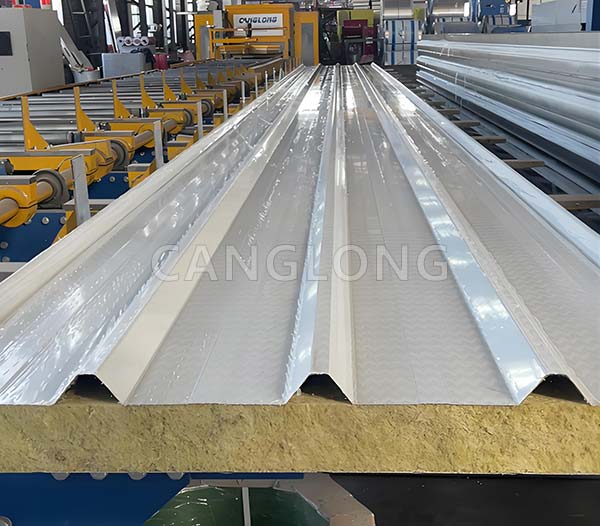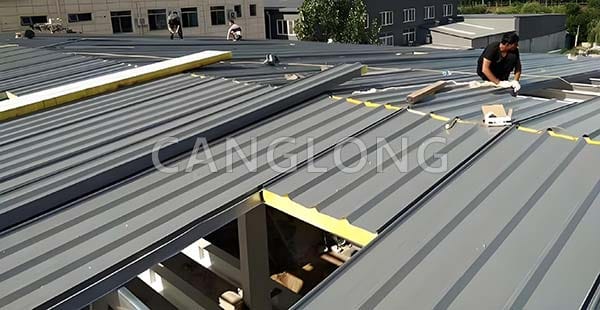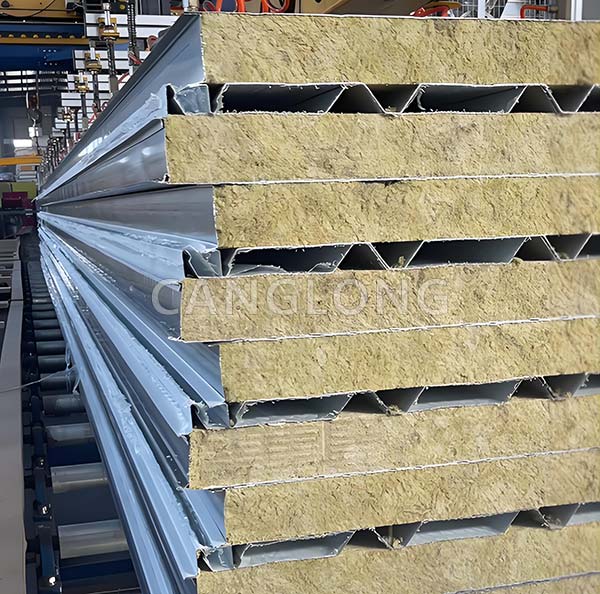Why choose rock wool roof panels for residential housing?
When building or renovating a roof, choosing the right material can save you ten years of worry. Faced with common options like asphalt shingles, color-coated steel tiles, and cement board, more and more families are turning to rock wool roof panels. This seemingly unassuming inorganic material is becoming the invisible guardian of residential roofs with its comprehensive advantages of safety, comfort, and cost-effectiveness.

1. Warm in Winter, Cool in Summer
What’s the most expensive aspect of a home? Energy consumption. Especially in cold, high-latitude regions (such as Canada and Northern Europe) or tropical hot zones (such as Southeast Asia and the Middle East), the roof serves as the largest heat exchange surface in a home, and its insulation performance directly determines air conditioning/heating costs.
One of the core advantages of rock wool roofing sheet is their inherent thermal insulation:
- With a low thermal conductivity (approximately 0.040 W/(m·K)), equivalent to 1/5 of concrete and 1/40 of steel of the same thickness, it effectively blocks heat intrusion from the outside and heat loss from within.
- High R-value (thermal resistance): A 100mm thick rock wool panel can achieve an R-value of 2.8, easily meeting European and American residential energy efficiency standards (such as the US IRC requirement for a roof R-value of ≥3.0).
- Breathable structure: Tiny pores between fibers create an air layer, providing both insulation and breathability, preventing mold and mildew problems caused by traditional waterproofing membranes.
Lars, a villa owner in Norway, reported, “After installing a rock wool roof panels, winter heating costs have dropped by 30%, and the top floor is less stuffy in the summer.”

2. Fireproofing Grade A
Fire is the number one threat to residential safety. According to 2023 data from the National Fire Protection Association, 38% of residential fires spread due to flammable roofing materials. Fire resistance is a top priority when choosing a roofing material.
Rock wool is a naturally non-combustible material (National Standard A1 / European Standard A2-s1,d0). It does not burn, drip, or release toxic gases when exposed to open flames. The fiber is primarily composed of basalt/diabase (accounting for over 98%), with a melting point exceeding 1000°C. It softens but does not burn at high temperatures.
Even if a fire breaks out elsewhere in the house, the rock wool roof panels provides a fire barrier for over 30 minutes, buying time for escape and rescue.
It complies with stringent global building codes such as EU EN 13501-1, US ASTM E84, and Australian AS 1530.1. Its lightweight and fire-resistant properties make it a top choice for low-rise residential buildings, particularly in seismic zones like Europe and Japan.
3. Quiet and Noise-Resistant
Who hasn’t experienced the noise of tiles crashing during a rainstorm or chairs being moved upstairs? The need for quiet in a home is often overlooked, yet crucial.
The porous sound-absorbing structure of the rock wool roof panel is a natural noise reducer:
- It absorbs over 80% of low- and mid-frequency noise (such as rain and wind noise). In real-world measurements, it can reduce noise transmitted from the roof by 15-20 decibels (equivalent to a noise level from a busy city to a library).
- When combined with gypsum board and keels to create a composite ceiling, the sound insulation is enhanced, making it particularly suitable for residences facing streets, near airports, or in residential public areas.

4. Durable and Worry-Free
The short lifespan and fragility of roofing materials are a major maintenance headache for households. Asphalt shingles can crack after 10 years, color-coated steel shingles rust after 5, and cement boards are bulky and difficult to repair…
The weather resistance of rock wool roof panels have been globally verified:
- Aging resistance: The inorganic fibers resist mold and insect damage, and maintain a 30-year strength retention rate of >80% under UV exposure (European EN 13500 test).
- Moisture and frost resistance: The closed-cell structure with optional hydrophobic treatment resists water absorption, expansion, and freeze-thaw cracking in humid Southeast Asia or cold Russia.
- Lightweight and low load bearing: At 10 kg/m2, the weight is only one-fifth that of a concrete slab, reducing roof loads and making it particularly suitable for renovations of older homes or timber-framed residences.
5. Conforming to the Green Building Trend
From Europe’s LEED certification to China’s “dual carbon” goals, green building has become a global residential mainstream. The environmentally friendly properties of rock wool roof panels perfectly align with this trend.
- Natural Raw Materials: 98% natural rock, no chemical adhesives, and 60% lower carbon emissions than cement production.
- Recyclable: After decommissioning, it can be crushed for backfill or used as building aggregate, reducing construction waste.
- Healthy and Friendly: Contains no volatiles like formaldehyde and benzene, meets WHO indoor air quality standards, and is particularly suitable for homes with elderly and children.

Summary
Some believe the initial cost of rock wool roofing sheet is 20%-30% higher than asphalt shingles. However, considering the long-term costs:
- Energy savings and electricity bills for over 15 years.
- Fireproofing reduces damage and maintenance.
- Sound insulation enhances living quality.
These hidden benefits more than offset the initial price difference. For families around the world, rock wool roof panel isn’t just a matter of price; it’s a matter of value. It protects life under every roof in a safer, more comfortable, and more worry-free way.
Next time you choose a roofing material, remember this: rock wool roof panels provides more than just protection from the elements; it also provides a lasting sense of security and well-being.
